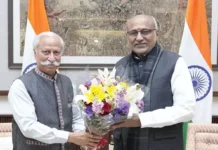[Indu Chukhu]
PACHIN, 1 Aug: Ever since the establishment of two 3D-printed classrooms in the government secondary school (GSS) here, it has created a buzz and has attracted high profile visitors but there remain several issues.
The Class 10 3D classroom accommodates 94 students in two sections. Initially, it had been built for the pre-primary level, but was later expanded to accommodate the Class 10 students.
Speaking to this daily, GSS Headmistress Ekthani Mounglang expressed happiness over the 3D-printed classrooms, saying that “the students can now watch videos online and learn from the interactive flat panel display; that way, it eases the work of a subject teacher also,” she said.
Sources said that the attendance record of the school’s teachers has also increased considerably.
The headmistress had earlier suggested that the school be designed as a Building as Learning Aid(BALA), which incorporates activity-based learning, child-friendliness, and inclusive education for children with special needs.
Each window of the 3D-printed classrooms has an abacus, besides alphabets and numbers, designed in them. The windows also have geometrical shapes; that way, students can easily learn them by seeing.
When parts of the school had been burnt down in a fire accident last year, the classrooms had been shifted to the school’s community hall. However, it could not stand till monsoon due to the muddiness of the school’s compound.
Mounglang informed that “currently three classrooms have been shifted to the classrooms that had been burnt down, after a little restoration.”
The school has a total of 397 students, which makes it difficult for the classrooms to accommodate all the students. Further, “one of the classrooms has been turned into a kitchen, in order to provide midday meals regularly,” she said.
A source in the school said on condition of anonymity that “the government could have constructed more classrooms, other than the 3D-printed ones.”
“One can notice that the way to the 3D-printed classrooms is muddy, owing to lack of a drainage system, which leads to rainwater collecting on the ground area,” the source said.
In this academic session, for the first time, the GSS is not taking admissions from feeder schools, such as the government middle school in Papu Nallah, as it has limited classrooms and seats.
“The school could only take students from two feeder schools, as there are few seats for admission,” informed the headmistress.
The school has enough area, and with proper support from the government, it could be turned into a model school in the capital region.
Presently, with limited classrooms in the school, the CBSE cell, which needs to function separately, is being accommodated in the school’s office and its home exam branch.




